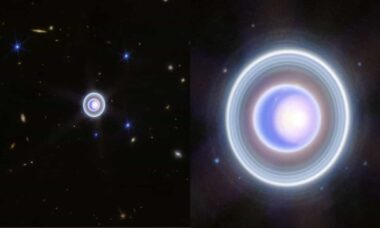James Webb avaruusteleskooppi keskittyi huomionsa Uranukseen ja onnistui napata kauniita yksityiskohtaisia kuvia jäisestä planeetasta, sen renkaista, kuista ja ilmakehän piirteistä, mukaan lukien kausittainen napakupu
Read MoreUranus
James Webb ujawnia nieznane dotąd szczegóły Uranusa na nowych zdjęciach
Teleskop Kosmiczny James Webb skoncentrował swoją uwagę na Uranusie i udało mu się uchwycić piękne, szczegółowe obrazy lodowej planety, jej pierścieni, księżyców i cech atmosferycznych, w tym sezonowej czapy polarniej
Read MoreJames Webb onthult ongekende details van Uranus in nieuwe foto’s
De James Webb Space Telescope richtte zijn aandacht op Uranus en slaagde erin prachtige gedetailleerde beelden vast te leggen van de ijsplaneet, zijn ringen, manen en atmosferische kenmerken, inclusief een seizoensgebonden poolkap.
Read MoreJames Webb enthüllt bisher unveröffentlichte Details von Uranus in neuen Fotos
Das James Webb Weltraumteleskop richtete seine Aufmerksamkeit auf Uranus und konnte wunderschöne, detaillierte Bilder des Eisplaneten, seiner Ringe, Monde und atmosphärischen Merkmale einfangen, einschließlich eines saisonalen Polarkreises.
Read MoreJames Webb révèle des détails inédits sur Uranus dans de nouvelles photos
Le Télescope spatial James Webb a concentré son attention sur Uranus et a réussi à capturer de magnifiques images détaillées de la planète de glace, de ses anneaux, de ses lunes et de ses caractéristiques atmosphériques, y compris une calotte polaire saisonnière.
Read MoreJames Webb reveals unprecedented details of Uranus in new photos
The James Webb Space Telescope focused its attention on Uranus and managed to capture beautiful detailed images of the ice planet, its rings, moons, and atmospheric features, including a seasonal polar cap.
Read MoreLa possibilité de trouver la vie sur une des lunes d’Uranus vient d’augmenter
Un article qui sera prochainement publié dans la revue Geophysical Research Letters attribue les observations de radiation du Voyager 2 à des molécules d’eau s’échappant d’une des lunes d’Uranus. Selon les chercheurs, cela pourrait indiquer la présence d’un océan interne et donc une chance de vie.
Read More


